
- •Features
- •Overview
- •Block Diagram
- •Pin Descriptions
- •Port A (PA2..PA0)
- •Port B (PB7..PB0)
- •Port D (PD6..PD0)
- •RESET
- •XTAL1
- •XTAL2
- •Resources
- •Code Examples
- •Disclaimer
- •AVR CPU Core
- •Introduction
- •Status Register
- •Stack Pointer
- •Erase
- •Write
- •I/O Memory
- •Clock Systems and their Distribution
- •CPU Clock – clkCPU
- •I/O Clock – clkI/O
- •Flash Clock – clkFLASH
- •Clock Sources
- •Crystal Oscillator
- •External Clock
- •Idle Mode
- •Power-down Mode
- •Standby Mode
- •Analog Comparator
- •Watchdog Timer
- •Port Pins
- •Resetting the AVR
- •Reset Sources
- •Power-on Reset
- •External Reset
- •Watchdog Reset
- •Watchdog Timer
- •Interrupts
- •I/O-Ports
- •Introduction
- •Configuring the Pin
- •Toggling the Pin
- •Reading the Pin Value
- •Alternate Port Functions
- •Register Description for I/O-Ports
- •8-bit Timer/Counter0 with PWM
- •Overview
- •Registers
- •Definitions
- •Counter Unit
- •Normal Mode
- •Fast PWM Mode
- •8-bit Timer/Counter Register Description
- •Timer/Counter0 and Timer/Counter1 Prescalers
- •Internal Clock Source
- •Prescaler Reset
- •External Clock Source
- •16-bit Timer/Counter1
- •Overview
- •Registers
- •Definitions
- •Compatibility
- •Counter Unit
- •Input Capture Unit
- •Noise Canceler
- •Force Output Compare
- •Normal Mode
- •Fast PWM Mode
- •16-bit Timer/Counter Register Description
- •USART
- •Overview
- •AVR USART vs. AVR UART – Compatibility
- •Clock Generation
- •External Clock
- •Frame Formats
- •Parity Bit Calculation
- •Parity Generator
- •Receiver Error Flags
- •Parity Checker
- •Disabling the Receiver
- •Using MPCM
- •Overview
- •Three-wire Mode
- •Two-wire Mode
- •4-bit Counter
- •12-bit Timer/Counter
- •Software Interrupt
- •Analog Comparator
- •Features
- •Overview
- •Physical Interface
- •Limitations of debugWIRE
- •debugWire Data Register – DWDR
- •Fuse Bits
- •Latching of Fuses
- •Signature Bytes
- •Calibration Byte
- •Page Size
- •Signal Names
- •Chip Erase
- •Reading the Flash
- •Reading the EEPROM
- •Electrical Characteristics
- •Absolute Maximum Ratings*
- •DC Characteristics
- •External Clock Drive Waveforms
- •Maximum Speed vs. VCC
- •Idle Supply Current
- •Pin Pull-up
- •Pin Driver Strength
- •Register Summary
- •Instruction Set Summary
- •Ordering Information
- •Packaging Information
- •Errata
- •ATtiny2313 Rev C
- •ATtiny2313 Rev B
- •ATtiny2313 Rev A
- •Changes from Rev. 2543H-02/05 to Rev. 2543I-04/06
- •Changes from Rev. 2543G-10/04 to Rev. 2543H-02/05
- •Changes from Rev. 2543F-08/04 to Rev. 2543G-10/04
- •Changes from Rev. 2543E-04/04 to Rev. 2543F-08/04
- •Changes from Rev. 2543D-03/04 to Rev. 2543E-04/04
- •Changes from Rev. 2543C-12/03 to Rev. 2543D-03/04
- •Changes from Rev. 2543B-09/03 to Rev. 2543C-12/03
- •Changes from Rev. 2543A-09/03 to Rev. 2543B-09/03
- •Table of Contents
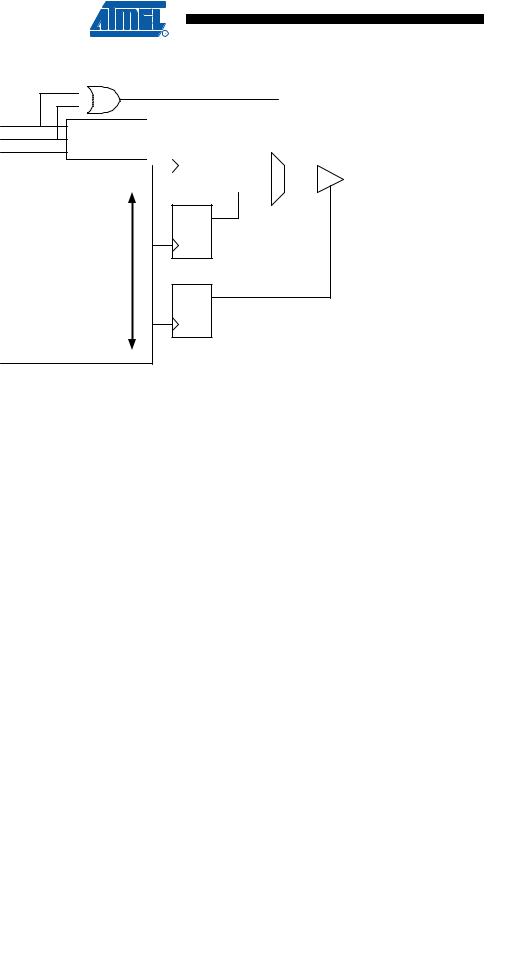
Figure 30. Compare Match Output Unit, Schematic
COMnx1
COMnx0 Waveform
FOCn Generator
DATA BUS
clkI/O
|
|
|
|
|
|
|
|
|
|
|
|
|
|
|
|
|
|
|
|
|
|
|
|
D Q |
|
|
|
|
|
|
|
|
|
|
|
|
|
|
|
|
|
|
|
|
|
|
|
|
|
|
|
|
|
|
|
|
|
|
|
1 |
|
|
|
|
|
|
|
|
|
|
|
|
|
|
|
OCn |
|
|
OCnx |
|
|
0 |
|
|
|
Pin |
|
|
|
|
|
|
|
|
|
|
||
 D Q
D Q
PORT
 D Q
D Q
DDR
The general I/O port function is overridden by the Output Compare (OC0x) from the Waveform Generator if either of the COM0x1:0 bits are set. However, the OC0x pin direction (input or output) is still controlled by the Data Direction Register (DDR) for the port pin. The Data Direction Register bit for the OC0x pin (DDR_OC0x) must be set as output before the OC0x value is visible on the pin. The port override function is independent of the Waveform Generation mode.
The design of the Output Compare pin logic allows initialization of the OC0x state before the output is enabled. Note that some COM0x1:0 bit settings are reserved for certain modes of operation. See “8-bit Timer/Counter Register Description” on page 73.
Compare Output Mode The Waveform Generator uses the COM0x1:0 bits differently in Normal, CTC, and PWM modes.
and Waveform |
For all modes, setting the COM0x1:0 = 0 tells the Waveform Generator that no action on the |
Generation |
OC0x Register is to be performed on the next Compare Match. For compare output actions in |
|
the non-PWM modes refer to Figure 29 on page 64. For fast PWM mode, refer to Table 26 on |
|
page 55, and for phase correct PWM refer to Table 27 on page 55. |
|
A change of the COM0x1:0 bits state will have effect at the first Compare Match after the bits are |
|
written. For non-PWM modes, the action can be forced to have immediate effect by using the |
|
FOC0x strobe bits. |
Modes of |
The mode of operation, i.e., the behavior of the Timer/Counter and the Output Compare pins, is |
Operation |
defined by the combination of the Waveform Generation mode (WGM02:0) and Compare Output |
|
mode (COM0x1:0) bits. The Compare Output mode bits do not affect the counting sequence, |
|
while the Waveform Generation mode bits do. The COM0x1:0 bits control whether the PWM out- |
|
put generated should be inverted or not (inverted or non-inverted PWM). For non-PWM modes |
|
the COM0x1:0 bits control whether the output should be set, cleared, or toggled at a Compare |
|
Match (See “Compare Match Output Unit” on page 65.). |
|
For detailed timing information refer to Figure 34, Figure 35, Figure 36 and Figure 37 in |
|
“Timer/Counter Timing Diagrams” on page 71. |
Normal Mode |
The simplest mode of operation is the Normal mode (WGM02:0 = 0). In this mode the counting |
|
direction is always up (incrementing), and no counter clear is performed. The counter simply |
|
overruns when it passes its maximum 8-bit value (TOP = 0xFF) and then restarts from the bot- |
|
tom (0x00). In normal operation the Timer/Counter Overflow Flag (TOV0) will be set in the same |
66 ATtiny2313 
2543L–AVR–08/10
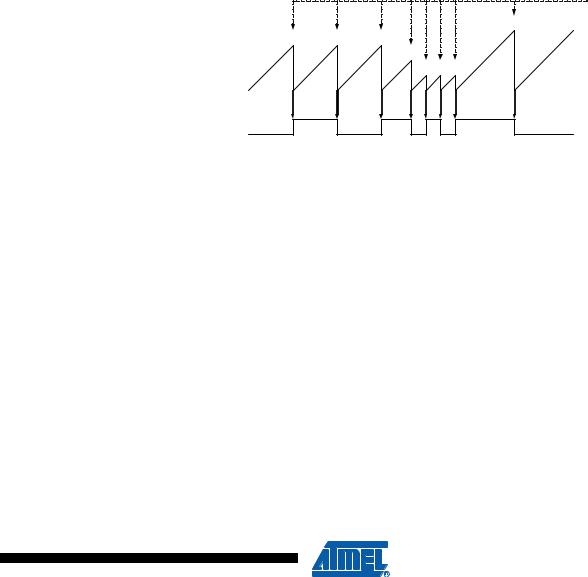
 ATtiny2313
ATtiny2313
timer clock cycle as the TCNT0 becomes zero. The TOV0 Flag in this case behaves like a ninth bit, except that it is only set, not cleared. However, combined with the timer overflow interrupt
|
that automatically clears the TOV0 Flag, the timer resolution can be increased by software. |
|
There are no special cases to consider in the Normal mode, a new counter value can be written |
|
anytime. |
|
The Output Compare Unit can be used to generate interrupts at some given time. Using the Out- |
|
put Compare to generate waveforms in Normal mode is not recommended, since this will |
|
occupy too much of the CPU time. |
Clear Timer on |
In Clear Timer on Compare or CTC mode (WGM02:0 = 2), the OCR0A Register is used to |
Compare Match (CTC) manipulate the counter resolution. In CTC mode the counter is cleared to zero when the counter
Mode |
value (TCNT0) matches the OCR0A. The OCR0A defines the top value for the counter, hence |
||||||||||||||||||
|
also its resolution. This mode allows greater control of the Compare Match output frequency. It |
||||||||||||||||||
|
also simplifies the operation of counting external events. |
||||||||||||||||||
|
The timing diagram for the CTC mode is shown in Figure 31. The counter value (TCNT0) |
||||||||||||||||||
|
increases until a Compare Match occurs between TCNT0 and OCR0A, and then counter |
||||||||||||||||||
|
(TCNT0) is cleared. |
||||||||||||||||||
|
Figure 31. CTC Mode, Timing Diagram |
||||||||||||||||||
|
|
|
|
|
|
|
|
|
|
|
|
|
|
|
|
|
|
|
|
|
|
|
|
|
|
|
|
|
|
|
|
|
|
|
|
|
|
OCnx Interrupt Flag Set |
|
|
|
|
|
|
|
|
|
|
|
|
|
|
|
|
|
|
|
|
|
|
|
|
|
|
|
|
|
|
|
|
|
|
|
|
|
|
|
|
|
|
|
|
|
|
|
|
|
|
|
|
|
|
|
|
|
|
|
|
|
|
|
|
|
|
|
|
|
|
|
|
|
|
|
|
|
|
|
|
|
|
|
|
|
|
|
|
|
|
|
|
|
|
|
|
|
|
|
|
|
TCNTn
OCn
(COMnx1:0 = 1)
(Toggle)
Period  1
1 
 2
2
 3
3 
 4
4

An interrupt can be generated each time the counter value reaches the TOP value by using the OCF0A Flag. If the interrupt is enabled, the interrupt handler routine can be used for updating the TOP value. However, changing TOP to a value close to BOTTOM when the counter is running with none or a low prescaler value must be done with care since the CTC mode does not have the double buffering feature. If the new value written to OCR0A is lower than the current value of TCNT0, the counter will miss the Compare Match. The counter will then have to count to its maximum value (0xFF) and wrap around starting at 0x00 before the Compare Match can occur.
For generating a waveform output in CTC mode, the OC0A output can be set to toggle its logical level on each Compare Match by setting the Compare Output mode bits to toggle mode (COM0A1:0 = 1). The OC0A value will not be visible on the port pin unless the data direction for the pin is set to output. The waveform generated will have a maximum frequency of fOC0 = fclk_I/O/2 when OCR0A is set to zero (0x00). The waveform frequency is defined by the following equation:
fOCnx = |
fclk_I/O |
2--------N---------(--1-----+-----OCRnx--------------------) |
The N variable represents the prescale factor (1, 8, 64, 256, or 1024).
67
2543L–AVR–08/10
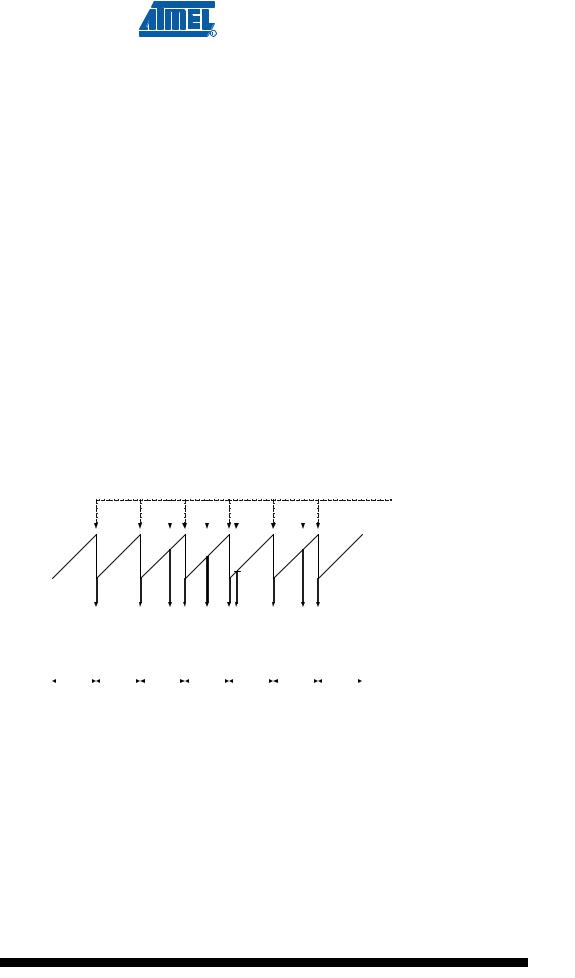
|
|
|
|
|
|
|
|
|
|
|
|
|
|
|
|
|
|
|
|
|
|
|
|
|
|
|
|
|
|
|
|
|
|
|
|
|
|
|
|
|
|
|
As for the Normal mode of operation, the TOV0 Flag is set in the same timer clock cycle that the |
|||||||||||||||||||
|
counter counts from MAX to 0x00. |
|||||||||||||||||||
Fast PWM Mode |
The fast Pulse Width Modulation or fast PWM mode (WGM02:0 = 3 or 7) provides a high fre- |
|||||||||||||||||||
|
quency PWM waveform generation option. The fast PWM differs from the other PWM option by |
|||||||||||||||||||
|
its single-slope operation. The counter counts from BOTTOM to TOP then restarts from BOT- |
|||||||||||||||||||
|
TOM. TOP is defined as 0xFF when WGM2:0 = 3, and OCR0A when WGM2:0 = 7. In non- |
|||||||||||||||||||
|
inverting Compare Output mode, the Output Compare (OC0x) is cleared on the Compare Match |
|||||||||||||||||||
|
between TCNT0 and OCR0x, and set at BOTTOM. In inverting Compare Output mode, the out- |
|||||||||||||||||||
|
put is set on Compare Match and cleared at BOTTOM. Due to the single-slope operation, the |
|||||||||||||||||||
|
operating frequency of the fast PWM mode can be twice as high as the phase correct PWM |
|||||||||||||||||||
|
mode that use dual-slope operation. This high frequency makes the fast PWM mode well suited |
|||||||||||||||||||
|
for power regulation, rectification, and DAC applications. High frequency allows physically small |
|||||||||||||||||||
|
sized external components (coils, capacitors), and therefore reduces total system cost. |
|||||||||||||||||||
|
In fast PWM mode, the counter is incremented until the counter value matches the TOP value. |
|||||||||||||||||||
|
The counter is then cleared at the following timer clock cycle. The timing diagram for the fast |
|||||||||||||||||||
|
PWM mode is shown in Figure 30. The TCNT0 value is in the timing diagram shown as a histo- |
|||||||||||||||||||
|
gram for illustrating the single-slope operation. The diagram includes non-inverted and inverted |
|||||||||||||||||||
|
PWM outputs. The small horizontal line marks on the TCNT0 slopes represent Compare |
|||||||||||||||||||
|
Matches between OCR0x and TCNT0. |
|||||||||||||||||||
|
Figure 32. Fast PWM Mode, Timing Diagram |
|||||||||||||||||||
|
|
|
|
|
|
|
|
|
|
|
|
|
|
|
|
|
|
|
|
|
|
|
|
|
|
|
|
|
|
|
|
|
|
|
|
|
|
|
|
OCRnx Interrupt Flag Set |
|
|
|
|
|
|
|
|
|
|
|
|
|
|
|
|
|
|
|
|
||
|
|
|
|
|
|
|
|
|
|
|
|
|
|
|
|
|
|
|
|
|
|
|
|
|
|
|
|
|
|
|
|
|
|
|
|
|
|
|
|
|
|
|
|
|
|
|
|
|
|
|
|
|
|
|
|
|
|
|
|
|
OCRnx Update and |
|
|
|
|
|
|
|
|
|
|
|
|
|
|
|
|
|
|
|
|
TOVn Interrupt Flag Set |
|
|
|
|
|
|
|
|
|
|
|
|
|
|
|
|
|
|
|
|
|
|
|
|
|
|
|
|
|
|
|
|
|
|
|
|
|
|
|
|
|
|
|
|
|
|
|
|
|
|
|
|
|
|
|
|
|
|
|
|
|
|
|
|
|
|
|
|
|
|
|
|
|
|
|
|
|
|
|
|
|
|
|
|
|
TCNTn
OCn |
|
|
|
|
|
|
|
|
|
|
|
|
|
|
|
|
|
|
|
|
|
|
|
|
|
|
|
|
|
|
|
|
|
|
|
|
|
|
|
|
(COMnx1:0 = 2) |
|
|
|
|
|
|
|
|
|
|
|
|
|
|
|
|
|
|
|
|
|
|
|
|
|
|
|
|
|
|
|
|
|
|
|
|
|
|
|
|
|
|
|
|
OCn |
|
|
|
|
|
|
|
|
|
|
|
|
|
|
|
|
|
|
|
|
|
|
|
|
|
|
|
|
|
|
|
|
|
|
|
|
|
|
|
|
(COMnx1:0 = 3) |
|
Period |
|
|
|
|
|
|
|
|
|
|
|
|
|
|
|
|
|
|
|
|
|
|
|
|
|
|
|
|
|
|
|
|
|
|
|
|
|
|
|
|
|
|
|
|
|
|
|
|
|
|
|
|
|
|
|
|
|
|
|
|
|
|
|
|
|
|
|
|
|
|
|
|
|
|
|
|
|
|
|
|
|
|
|
||
|
|
1 |
|
|
|
|
2 |
|
|
|
|
3 |
|
|
|
|
|
4 |
|
|
|
|
|
5 |
|
|
|
|
6 |
|
|
|
|
|
7 |
|
|
|
|
|||
|
|
|
|
|
|
|
|
|
|
|
|
|
|
|
|
|
|
|||||||||||||||||||||||||
|
|
|
|
|
|
|
|
|
|
|
|
|
|
|
|
|
|
|
|
|
|
|
|
|
|
|
|
|
|
|
|
|
|
|
|
|
|
|
|
|
|
|
The Timer/Counter Overflow Flag (TOV0) is set each time the counter reaches TOP. If the interrupt is enabled, the interrupt handler routine can be used for updating the compare value.
In fast PWM mode, the compare unit allows generation of PWM waveforms on the OC0x pins. Setting the COM0x1:0 bits to two will produce a non-inverted PWM and an inverted PWM output can be generated by setting the COM0x1:0 to three: Setting the COM0A1:0 bits to one allows the AC0A pin to toggle on Compare Matches if the WGM02 bit is set. This option is not available for the OC0B pin (See Table 26 on page 55). The actual OC0x value will only be visible on the port pin if the data direction for the port pin is set as output. The PWM waveform is generated by setting (or clearing) the OC0x Register at the Compare Match between OCR0x and TCNT0, and clearing (or setting) the OC0x Register at the timer clock cycle the counter is cleared (changes from TOP to BOTTOM).
68 ATtiny2313
2543L–AVR–08/10

 ATtiny2313
ATtiny2313
The PWM frequency for the output can be calculated by the following equation:
fOCnxPWM = |
fclk_I/O |
N---------256-------- |
The N variable represents the prescale factor (1, 8, 64, 256, or 1024).
The extreme values for the OCR0A Register represents special cases when generating a PWM waveform output in the fast PWM mode. If the OCR0A is set equal to BOTTOM, the output will be a narrow spike for each MAX+1 timer clock cycle. Setting the OCR0A equal to MAX will result in a constantly high or low output (depending on the polarity of the output set by the COM0A1:0 bits.)
A frequency (with 50% duty cycle) waveform output in fast PWM mode can be achieved by setting OC0x to toggle its logical level on each Compare Match (COM0x1:0 = 1). The waveform generated will have a maximum frequency of fOC0 = fclk_I/O/2 when OCR0A is set to zero. This feature is similar to the OC0A toggle in CTC mode, except the double buffer feature of the Output Compare unit is enabled in the fast PWM mode.
Phase Correct PWM The phase correct PWM mode (WGM02:0 = 1 or 5) provides a high resolution phase correct Mode PWM waveform generation option. The phase correct PWM mode is based on a dual-slope operation. The counter counts repeatedly from BOTTOM to TOP and then from TOP to BOTTOM. TOP is defined as 0xFF when WGM2:0 = 1, and OCR0A when WGM2:0 = 5. In noninverting Compare Output mode, the Output Compare (OC0x) is cleared on the Compare Match between TCNT0 and OCR0x while upcounting, and set on the Compare Match while downcounting. In inverting Output Compare mode, the operation is inverted. The dual-slope operation has lower maximum operation frequency than single slope operation. However, due to the symmetric feature of the dual-slope PWM modes, these modes are preferred for motor control
applications.
In phase correct PWM mode the counter is incremented until the counter value matches TOP. When the counter reaches TOP, it changes the count direction. The TCNT0 value will be equal to TOP for one timer clock cycle. The timing diagram for the phase correct PWM mode is shown on Figure 33. The TCNT0 value is in the timing diagram shown as a histogram for illustrating the dual-slope operation. The diagram includes non-inverted and inverted PWM outputs. The small horizontal line marks on the TCNT0 slopes represent Compare Matches between OCR0x and TCNT0.
69
2543L–AVR–08/10
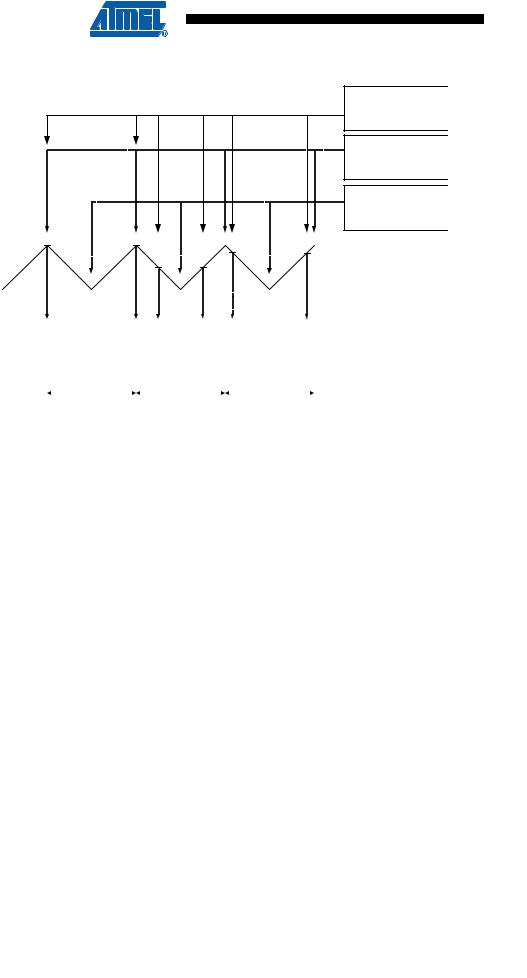
Figure 33. Phase Correct PWM Mode, Timing Diagram
OCnx Interrupt Flag Set
OCRnx Update
TOVn Interrupt Flag Set
TCNTn
OCn |
|
|
|
|
|
|
|
|
|
|
|
|
|
|
|
|
|
|
|
|
(COMnx1:0 = 2) |
|
|
|
|
|
|
|
|
|
|
|
|
|
|
|
|
|
|
|
|
|
|
|
|
|
|
|
|
|
|
|
|
|
|
|
|
|
|
|
|
|
|
|
|
|
|
|
OCn |
|
|
|
|
|
|
|
|
|
|
|
|
|
|
|
|
|
|
|
(COMnx1:0 = 3) |
||
|
|
|
|
|
|
|
|
|
|
|
|
|
|
|
|
|
|
|
||||
|
|
|
|
|
|
|
|
|
|
|
|
|
|
|
|
|
|
|
|
|
|
|
Period |
|
|
|
|
|
|
|
|
|
|
|
|
|
|
|
|
|
|
|
|
||
|
|
|
|
|
|
|
|
|
|
|
|
|
|
|
|
|
|
|
|
|||
|
|
1 |
|
|
|
|
|
2 |
|
|
|
|
|
|
3 |
|
|
|
|
|||
|
|
|
|
|
|
|
|
|
|
|
||||||||||||
|
|
|
|
|
|
|
|
|
|
|
|
|
|
|
|
|
|
|
|
|
|
|
The Timer/Counter Overflow Flag (TOV0) is set each time the counter reaches BOTTOM. The Interrupt Flag can be used to generate an interrupt each time the counter reaches the BOTTOM value.
In phase correct PWM mode, the compare unit allows generation of PWM waveforms on the OC0x pins. Setting the COM0x1:0 bits to two will produce a non-inverted PWM. An inverted PWM output can be generated by setting the COM0x1:0 to three: Setting the COM0A0 bits to one allows the OC0A pin to toggle on Compare Matches if the WGM02 bit is set. This option is not available for the OC0B pin (See Table 27 on page 55). The actual OC0x value will only be visible on the port pin if the data direction for the port pin is set as output. The PWM waveform is generated by clearing (or setting) the OC0x Register at the Compare Match between OCR0x and TCNT0 when the counter increments, and setting (or clearing) the OC0x Register at Compare Match between OCR0x and TCNT0 when the counter decrements. The PWM frequency for the output when using phase correct PWM can be calculated by the following equation:
fOCnxPCPWM = |
fclk_I/O |
N---------510-------- |
The N variable represents the prescale factor (1, 8, 64, 256, or 1024).
The extreme values for the OCR0A Register represent special cases when generating a PWM waveform output in the phase correct PWM mode. If the OCR0A is set equal to BOTTOM, the output will be continuously low and if set equal to MAX the output will be continuously high for non-inverted PWM mode. For inverted PWM the output will have the opposite logic values.
At the very start of period 2 in Figure 33 OCn has a transition from high to low even though there is no Compare Match. The point of this transition is to guarantee symmetry around BOTTOM. There are two cases that give a transition without Compare Match.
•OCR0A changes its value from MAX, like in Figure 33. When the OCR0A value is MAX the OCn pin value is the same as the result of a down-counting Compare Match. To ensure symmetry around BOTTOM the OCn value at MAX must correspond to the result of an upcounting Compare Match.
70 ATtiny2313 
2543L–AVR–08/10
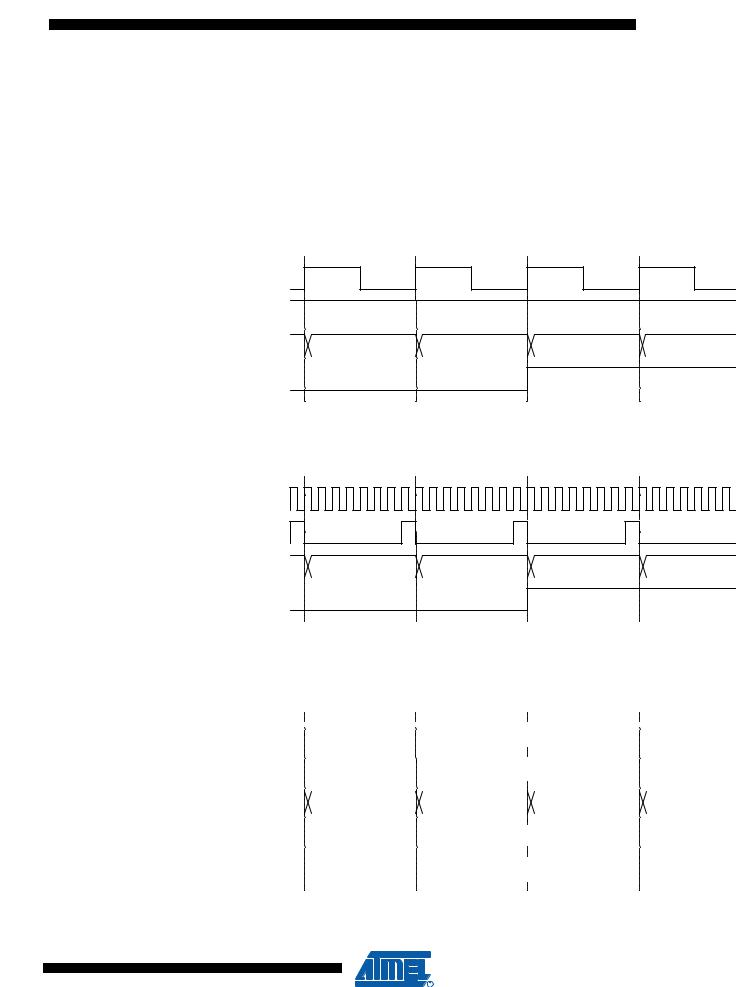
Timer/Counter
Timing Diagrams
ATtiny2313
•The timer starts counting from a value higher than the one in OCR0A, and for that reason misses the Compare Match and hence the OCn change that would have happened on the way up.
The Timer/Counter is a synchronous design and the timer clock (clkT0) is therefore shown as a clock enable signal in the following figures. The figures include information on when Interrupt Flags are set. Figure 34 contains timing data for basic Timer/Counter operation. The figure shows the count sequence close to the MAX value in all modes other than phase correct PWM mode.
Figure 34. Timer/Counter Timing Diagram, no Prescaling
clkI/O
clkTn
(clkI/O/1)
TCNTn |
MAX - 1 |
|
MAX |
|
BOTTOM |
|
BOTTOM + 1 |
||
|
|
|
|
|
|
|
|
|
|
TOVn
Figure 34 shows the same timing data, but with the prescaler enabled.
Figure 35. Timer/Counter Timing Diagram, with Prescaler (fclk_I/O/8)
clkI/O
clkTn
(clkI/O/8)
TCNTn |
MAX - 1 |
|
MAX |
|
BOTTOM |
|
BOTTOM + 1 |
||
|
|
|
|
|
|
|
|
|
|
TOVn
Figure 36 shows the setting of OCF0B in all modes and OCF0A in all modes except CTC mode and PWM mode, where OCR0A is TOP.
Figure 36. Timer/Counter Timing Diagram, Setting of OCF0x, with Prescaler (fclk_I/O/8)
clkI/O |
|
|
|
|
|
|
|
|
|
|
|
|
|
|
|
|
|
|
|
|
|
|
|
|
|
|
|
|
|
|
|
|
|
|
|
|
|
|
|
|
|
|
|
|
|
|
|
|
|
|
|
|
|
|
|
|
|
|
|
|
|
|
|
|
|
clkTn |
|
|
|
|
|
|
|
|
|
|
|
|
|
|
|
|
|
|
|
|
|
|
|
|
|
|
|
|
|
|
|
|
|
|
|
|
|
|
|
|
|
|
|
|
|
|
|
|
|
|
|
|
|
|
|
|
|
|
|
|
|
|
|
|
|
|
|
|
|
|
|
|
|
|
|
|
|
|
|
|
|
|
|
|
|
|
|
|
|
|
|
|
|
|
|
|
|
|
|
|
|
|
|
|
|
|
|
|
|
|
|
|
|
|
|
|
|
|
|
|
|
|
|
|
|
|
|
|
|
|
|
|
|
|
|
|
|
|
|
|
|
|
|
|
|
|
|
|
|
|
|
|
|
|
|
|
|
|
|
|
|
|
|
|
|
|
|
|
|
|
|
|
|
|
|
|
|
|
|
|
|
|
|
|
|
|
|
|
|
|
|
|
|
|
|
|
|
(clkI/O/8) |
|
|
|
|
|
|
|
|
|
|
|
|
|
|
|
|
|
|
|
|
|
|
|
|
|
|
|
|
|
|
|
|
|
|
|
|
|
|
|
|
|
|
|
|
|
|
|
|
|
|
|
|
|
|
|
|
|
|
|
|
|
|
|
|
|
|
|
|
|
|
|
|
|
|
|
|
|
|
|
|
|
|
|
|
|
|
|
|
|
|
|
|
|
|
|
|
|
|
|
|
|
|
|||||||||||||||||||||||||||||
TCNTn |
|
|
|
|
|
|
|
|
OCRnx - 1 |
|
|
|
|
|
|
|
|
|
|
OCRnx |
|
|
OCRnx + 1 |
|
|
|
|
|
|
|
|
OCRnx + 2 |
|
|
|||||||||||||||||||||||||||||||
OCRnx |
|
|
|
|
|
|
|
|
|
|
|
|
|
|
|
|
|
|
|
|
|
|
|
|
|
|
|
|
|
|
|
|
|
|
|
|
|
|
|
|
|
|
|
|
|
|
|
|
|
|
|
|
|
|
|
|
|
||||||||
|
|
|
|
|
|
|
|
|
|
|
|
|
|
|
|
|
|
|
|
|
|
|
|
|
|
|
|
|
|
|
|
|
|
|
|
|
|
|
|
|
|
|
|
|
|
|
|
|
|
|
|
|
|
|
|
|
|
|
|
|
|
|
|
||
|
|
|
|
|
|
|
|
|
|
|
|
|
|
|
|
|
|
|
|
|
|
|
|
|
|
|
|
|
OCRnx Value |
|
|
|
|
|
|
|
|
|
|
|
|
|
|
|
|
|
|
|
|
|
|
|
|
|
|
||||||||||
OCFnx |
|
|
|
|
|
|
|
|
|
|
|
|
|
|
|
|
|
|
|
|
|
|
|
|
|
|
|
|
|
|
|
|
|
|
|
|
|
|
|
|
|
|
|
|
|
|
|
|
|
|
|
|
|
|
|
|
|
|
|
|
|
|
|
|
|
|
|
|
|
|
|
|
|
|
|
|
|
|
|
|
|
|
|
|
|
|
|
|
|
|
|
|
|
|
|
|
|
|
|
|
|
|
|
|
|
|
|
|
|
|
|
|
|
|
|
|
|
|
|
|
|
|
|
|
|
|
|
|
|
||
|
|
|
|
|
|
|
|
|
|
|
|
|
|
|
|
|
|
|
|
|
|
|
|
|
|
|
|
|
|
|
|
|
|
|
|
|
|
|
|
|
|
|
|
|
|
|
|
|
|
|
|
|
|
|
|
|
|
|
|
|
|
|
|
||
|
|
|
|
|
|
|
|
|
|
|
|
|
|
|
|
|
|
|
|
|
|
|
|
|
|
|
|
|
|
|
|
|
|
|
|
|
|
|
|
|
|
|
|
|
|
|
|
|
|
|
|
|
|
|
|
|
|
|
|
|
|
|
|
|
|
Figure 37 shows the setting of OCF0A and the clearing of TCNT0 in CTC mode and fast PWM mode where OCR0A is TOP.
71
2543L–AVR–08/10
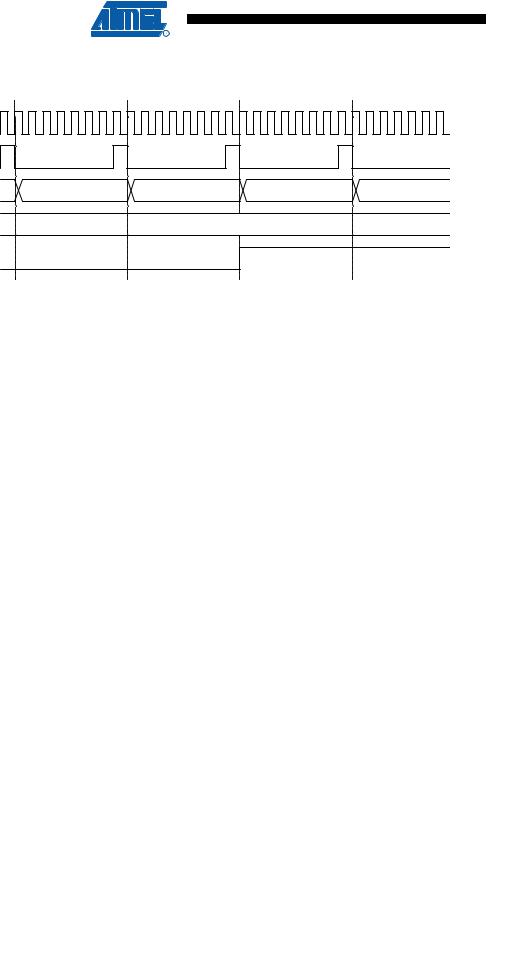
Figure 37. Timer/Counter Timing Diagram, Clear Timer on Compare Match mode, with Prescaler (fclk_I/O/8)
clkI/O |
|
|
|
|
|
clkTn |
|
|
|
|
|
(clkI/O/8) |
|
|
|
|
|
TCNTn |
TOP - 1 |
TOP |
BOTTOM |
BOTTOM + 1 |
|
(CTC) |
|||||
|
|
|
|
||
OCRnx |
|
|
TOP |
|
|
OCFnx |
|
|
|
|
72 ATtiny2313 
2543L–AVR–08/10
